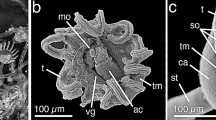Abstract
Tentacles excised from syphistoma polyps of Aurelia aurita undergo rapid regeneration to form whole polyps following exposure to an excess or absence of specific ions. It has been shown that a 12–18 h exposure of isolated tentacles to 58 mM excess of Cs+ results in a rapid firing of nematocysts, followed by an accelerated, synchronous polyp morphogenesis. Absence of Mgt2+ from the culture solution for 4–24 h also led to an accelerated, synchronous polyp regeneration. In either experimental set-up, incubation in 5–10 mM hydroxyurea effectively halted regeneration. Exposure to an excess of Li+ (50–200 mm) or K+ (10–50 mM) caused no firing of nematocysts and a percentage of polyp regeneration only slightly higher than control tentacles. Use of the K+ channel blocker tetraethylammonium (TEA; 100–300 mM) lead to similar levels of regeneration. A Ca2+ or K+-reduced artificial culture solution did not enhance regeneration. Ouabain (1 mM) dampened the Cs+ induced acceleration of polyp morphogenesis, and when given without Cs+, elicited a control level response.
Similar content being viewed by others
References
Archer W, Thomas MB (1984) An SEM study of morphological changes during metamorphosis in Pennaria tiarella. Proc Southeast Electron Microsc Soc 7:21
Berking S (1988) Ammonia, tetraethylammonium, barium and amiloride induce metamorphosis in the marine hydroid Hydractinia. Roux's Arch Dev Biol 197:1–9
Berking S (1991) Control of metamorphosis and pattern formation in Hydractinia (Hydrozoa, Cnidaria). BioEssays 13:323–329
Berridge MJ, Irvine RF (1989) Inositol phosphates and cell signalling. Nature 341:197–205
Freeman G (1981) The role of polarity in the development of the hydrozoan planula larva. Roux's Arch Dev Biol 190:168–184
Freeman G, Ridgway EB (1987) Endogenous photoproteins, calcium channels, and calcium transients during metamorphosis in hydrozoans. Roux's Arch Dev Biol 196:30–50
Leitz T, Klingmann G (1990) Metamorphosis in Hydractinia: studies with activators and inhibitors aiming at protein kinase C and potassium channels. Roux's Arch Dev Biol 199:107–113
Leitz T, Müller WA (1987) Evidence for the involvement of PI-signaling and diacylglycerol second messengers in the initiation of metamorphosis in the hydroid Hydractinia echinata Fleming. Dev Biol 121:82–89
Lesh-Laurie GE, Corriel R (1973) Scyphistoma regeneration from isolated tentacles in Aurelia aurita. J Mar Biol Assoc UK 53:885–894
Lesh-Laurie GE, Hujer A, Suchy P (1991) Polyp regeneration from isolated tentacles of Aurelia scyphistomae: a role for gating mechanisms and cell division. Hydrobiologia 216/217: 91–97
Loomis WF, Lenhoff HM (1956) Growth and sexual differentiation of Hydra in mass culture. J Exp Zool 132:555–574
Müller WA (1985) Tumor-promoting phorbol esters induce metamorphosis and multiple head formation in the hydroid Hydractinia. Differentiation 29:216–222
Müller WA, Buchal G (1973) Metamorphosis-Induktion bei Planula-Larven. II. Induktion durch monovalente Kationen: Die Bedeutung des Gibbs-Donnan Verhältnisses und der Na+/K+-ATPase. Roux's Arch Dev Biol 173:122–135
Müller WA, Mitze A, Wickhorst JP, Meier-Menge HM (1977) Polar morphogenesis in early hydroid development: action of caesium, or neurotransmitters and of an intrinsic head activator on pattern formation. Roux's Arch Dev Biol 182:311–328
Plickert G, Kroiher M, Munck A (1988) Cell proliferation and early differentiation during embryonic development and metamorphosis of Hydractinia echinata. Development 103: 795–803
Schwoerer-Böning B, Kroiher M, Müller WA (1990) Signal transmission and covert prepattern in the metamorphosis of Hydractinia echinata (Hydrozoa). Roux's Arch Dev Biol 198:245–251
Spencer AN (1982) The physiology of a coelenterate neuromuscular synapse. J Comp Physiol 148:353–363
Author information
Authors and Affiliations
Rights and permissions
About this article
Cite this article
Hujer, A., Lesh-Laurie, G.E. Effect of mono- and divalent cations on polyp morphogenesis in isolated tentacles of Aurelia aurita(Scyphozoa). Roux's Arch Dev Biol 205, 122–127 (1995). https://doi.org/10.1007/BF00357758
Received:
Accepted:
Issue Date:
DOI: https://doi.org/10.1007/BF00357758




